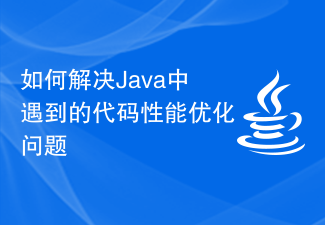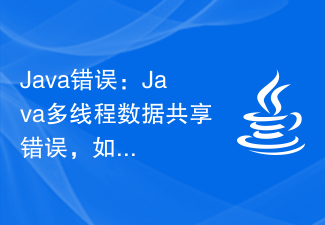 Backend Development
Backend Development C++
C++ The impact of C++ function memory allocation and destruction on multi-threaded programming
The impact of C++ function memory allocation and destruction on multi-threaded programmingAnswer: In multi-threaded programming, the mechanisms related to function memory allocation and destruction affect concurrency safety. Detailed description: Memory allocation: The new operator dynamically allocates memory on the heap, which may cause data races in a multi-threaded environment. Memory destruction: The destructor releases the memory occupied by the object, which may also cause data competition in a multi-threaded environment. Practical case: If the func function allocates dynamic memory without synchronization mechanism, data race may occur. Solution: Use RAII technology, which allocates memory when the function enters and releases it when it exits, to avoid data race risks.

C The impact of function memory allocation and destruction on multi-threaded programming
In multi-thread programming, understanding the function memory allocation and destruction mechanism is crucial to ensuring concurrency safety Crucial. This article will explore the impact of these mechanisms and provide practical examples to deepen understanding.
Memory Allocation
In C, memory allocation on functions usually uses the new operator. When a new object is created, new allocates memory space for the object on the heap. This operation is called Dynamic Memory Allocation.
Multi-threading impact:
In a multi-threaded environment, multiple threads may access dynamically allocated memory at the same time. If multiple threads try to access the same memory at the same time, data race will occur, which may cause the program to crash.
Memory destruction
When the object is destroyed, the memory will be released back to the heap. In C, object destruction is usually taken care of by destructors. The destructor is called at the end of the object's life cycle to release the memory occupied by the object.
Multi-threading impact:
Similar to memory allocation, destructor calls may also cause data races. If multiple threads try to destroy the same object at the same time, it may cause the program to crash.
Practical case
Consider the following code example:
#include <thread>
#include <mutex>
std::mutex m;
void func() {
std::unique_lock<std::mutex> lock(m);
// 执行一些需要互斥访问的操作...
}
int main() {
std::thread threads[10];
for (int i = 0; i < 10; i++) {
threads[i] = std::thread(func);
}
for (int i = 0; i < 10; i++) {
threads[i].join();
}
}In this example, the func function uses a mutex lockm to protect shared resources. However, if dynamic memory is allocated in the func function and there is no correct synchronization mechanism, data races may occur.
In order to solve this problem, you can use RAII (resource acquisition is initialization) technology in the func function, that is, allocate memory when the function enters, and when the function exits Free up memory.
void func() {
std::unique_lock<std::mutex> lock(m);
// 动态分配内存
int* p = new int;
// 使用 p 来执行一些操作...
// 在函数退出时释放内存
delete p;
}By using RAII, the risk of data races is avoided by ensuring that dynamically allocated memory is always released when the function exits.
The above is the detailed content of The impact of C++ function memory allocation and destruction on multi-threaded programming. For more information, please follow other related articles on the PHP Chinese website!
 聊聊Node.js中的多进程和多线程Jul 25, 2022 pm 07:45 PM
聊聊Node.js中的多进程和多线程Jul 25, 2022 pm 07:45 PM大家都知道 Node.js 是单线程的,却不知它也提供了多进(线)程模块来加速处理一些特殊任务,本文便带领大家了解下 Node.js 的多进(线)程,希望对大家有所帮助!
 优化Java文件写入多线程性能的方法有哪些Jul 01, 2023 am 10:05 AM
优化Java文件写入多线程性能的方法有哪些Jul 01, 2023 am 10:05 AMJava开发中如何优化文件写入多线程并发性能在大规模数据处理的场景中,文件的读写操作是不可避免的,而且在多线程并发的情况下,如何优化文件的写入性能变得尤为重要。本文将介绍一些在Java开发中优化文件写入多线程并发性能的方法。合理使用缓冲区在文件写入过程中,使用缓冲区可以大大提高写入性能。Java提供了多种缓冲区实现,如ByteBuffer、CharBuffe
 如何优化C++开发中的多线程调度效率Aug 22, 2023 am 09:33 AM
如何优化C++开发中的多线程调度效率Aug 22, 2023 am 09:33 AM在当今的软件开发领域中,多线程编程已经成为了一种常见的开发模式。而在C++开发中,多线程调度的效率优化是开发者需要关注和解决的一个重要问题。本文将围绕如何优化C++开发中的多线程调度效率展开讨论。多线程编程的目的是为了充分利用计算机的多核处理能力,提高程序运行效率和响应速度。然而,在并行执行的同时,多线程之间的竞争条件和互斥操作可能导致线程调度的效率下降。为
 Python服务器编程:利用多线程解决并发问题Jun 19, 2023 am 08:45 AM
Python服务器编程:利用多线程解决并发问题Jun 19, 2023 am 08:45 AM随着互联网的发展,越来越多的应用程序被开发出来,它们需要处理并发请求。例如,Web服务器需要处理多个客户端请求。在处理并发请求时,服务器需要同时处理多个请求。这时候,Python中的多线程技术就可以派上用场了。本文将介绍如何使用Python多线程技术解决并发问题。首先,我们将了解什么是多线程。然后,我们将讨论使用多线程的优点和缺点。最后,我们将演示一个实例,
 如何使用PHP多线程执行多个方法Mar 23, 2023 pm 02:11 PM
如何使用PHP多线程执行多个方法Mar 23, 2023 pm 02:11 PM在PHP开发中,经常会遇到需要同时执行多个操作的情况。想要在一个进程中同时执行多个耗时操作,就需要使用PHP的多线程技术来实现。本文将介绍如何使用PHP多线程执行多个方法,提高程序的并发性能。
 如何解决Java中遇到的代码性能优化问题Jun 29, 2023 am 10:13 AM
如何解决Java中遇到的代码性能优化问题Jun 29, 2023 am 10:13 AM如何解决Java中遇到的代码性能优化问题随着现代软件应用的复杂性和数据量的增加,对于代码性能的需求也变得越来越高。在Java开发中,我们经常会遇到一些性能瓶颈,如何解决这些问题成为了开发者们关注的焦点。本文将介绍一些常见的Java代码性能优化问题,并提供一些解决方案。一、避免过多的对象创建和销毁在Java中,对象的创建和销毁是需要耗费资源的。因此,当一个方法
 Java错误:Java多线程数据共享错误,如何处理和避免Jun 25, 2023 am 11:16 AM
Java错误:Java多线程数据共享错误,如何处理和避免Jun 25, 2023 am 11:16 AM随着社会的发展和科技的进步,计算机程序已经渐渐成为我们生活中不可或缺的一部分。而Java作为一种流行的编程语言,以其可移植性、高效性和面向对象特性等而备受推崇。然而,Java程序开发过程中可能会出现一些错误,如Java多线程数据共享错误,这对于程序员们来说并不陌生。在Java程序中,多线程是非常常见的,开发者通常会使用多线程来优化程序的性能。多线程能够同时处
 刨析swoole开发功能的多线程与多进程调度方式Aug 05, 2023 pm 01:43 PM
刨析swoole开发功能的多线程与多进程调度方式Aug 05, 2023 pm 01:43 PM刨析swoole开发功能的多线程与多进程调度方式随着互联网技术的发展,对服务器性能的要求越来越高。在高并发场景下,传统的单线程模型往往无法满足需求,因此诞生了多线程和多进程调度方式。swoole作为一种高性能的网络通信引擎,提供了多线程和多进程的开发功能,本文将对其进行深入分析和探讨。一、多线程调度方式线程概念介绍线程是操作系统能够进行运算调度的最小单位。在


Hot AI Tools

Undresser.AI Undress
AI-powered app for creating realistic nude photos

AI Clothes Remover
Online AI tool for removing clothes from photos.

Undress AI Tool
Undress images for free

Clothoff.io
AI clothes remover

AI Hentai Generator
Generate AI Hentai for free.

Hot Article

Hot Tools

PhpStorm Mac version
The latest (2018.2.1) professional PHP integrated development tool

Safe Exam Browser
Safe Exam Browser is a secure browser environment for taking online exams securely. This software turns any computer into a secure workstation. It controls access to any utility and prevents students from using unauthorized resources.

SublimeText3 English version
Recommended: Win version, supports code prompts!

Dreamweaver CS6
Visual web development tools

SublimeText3 Mac version
God-level code editing software (SublimeText3)






